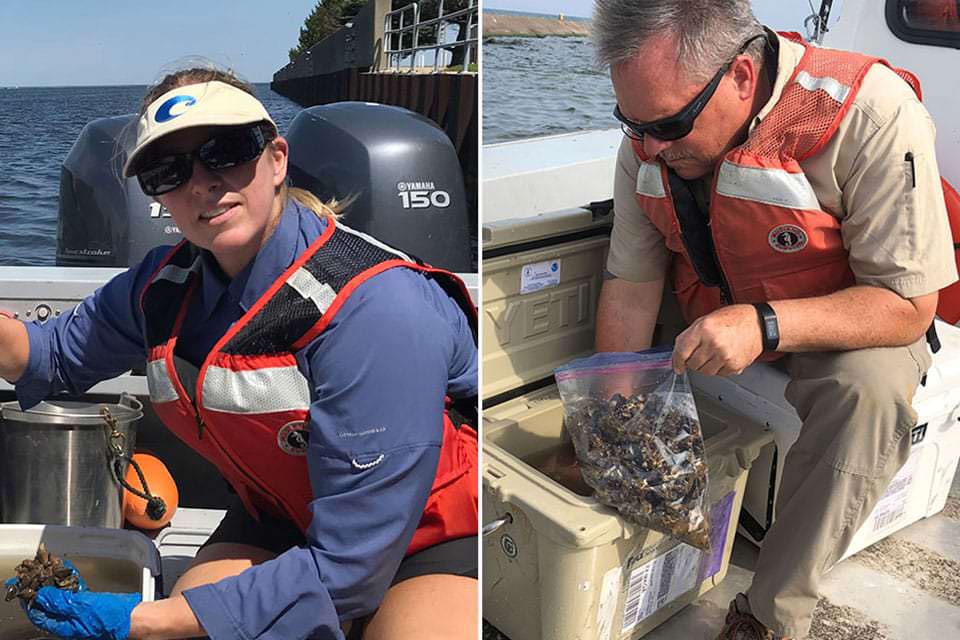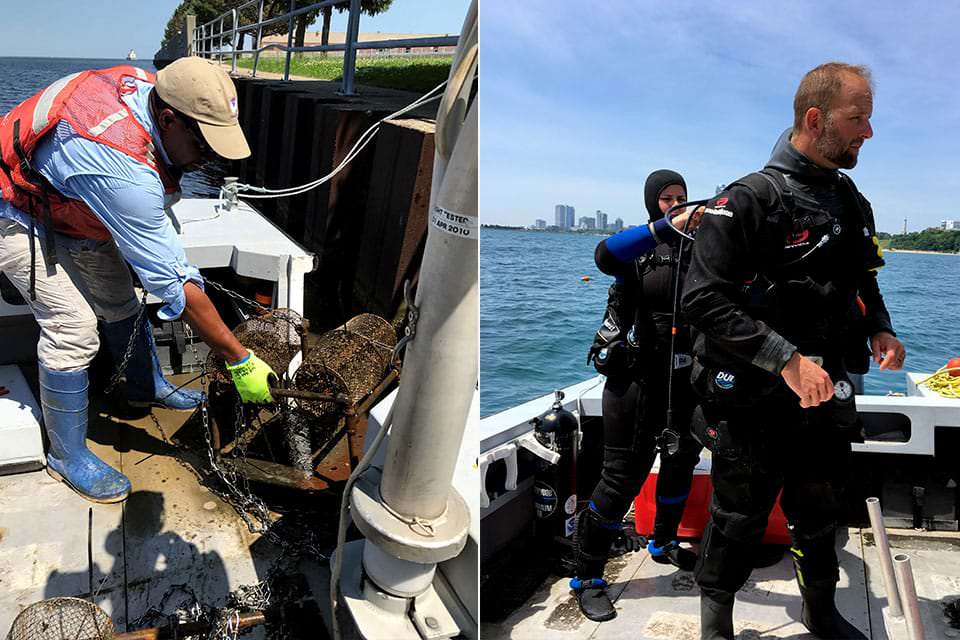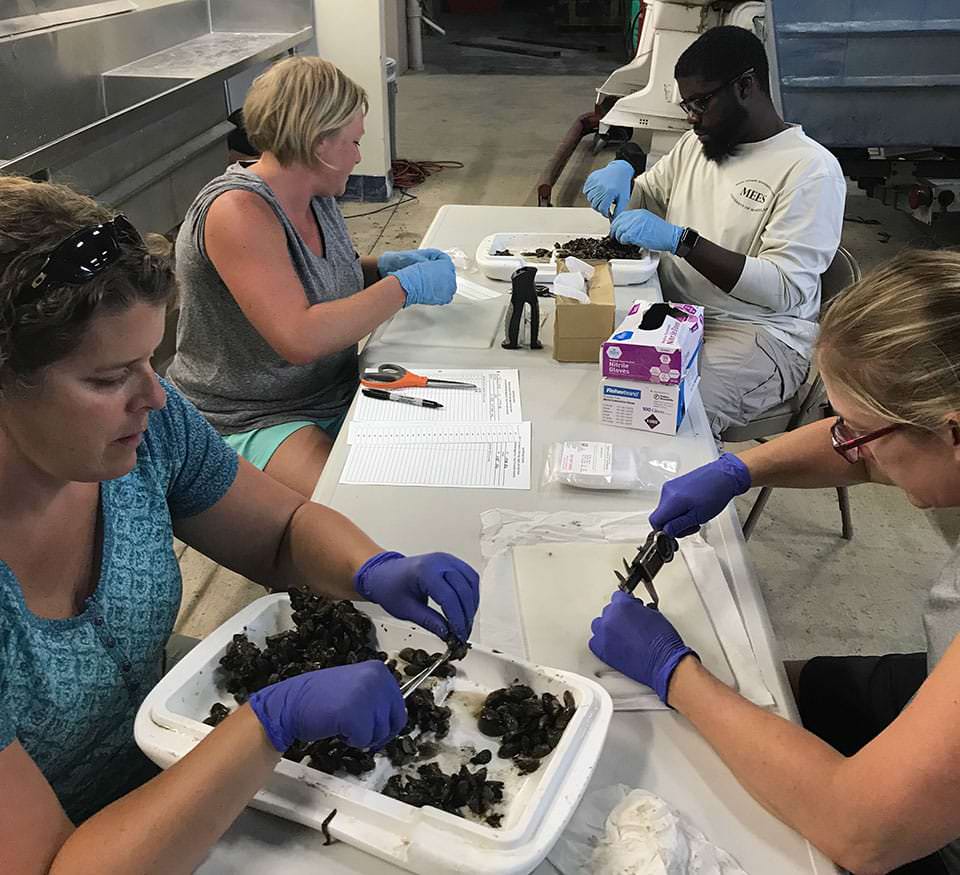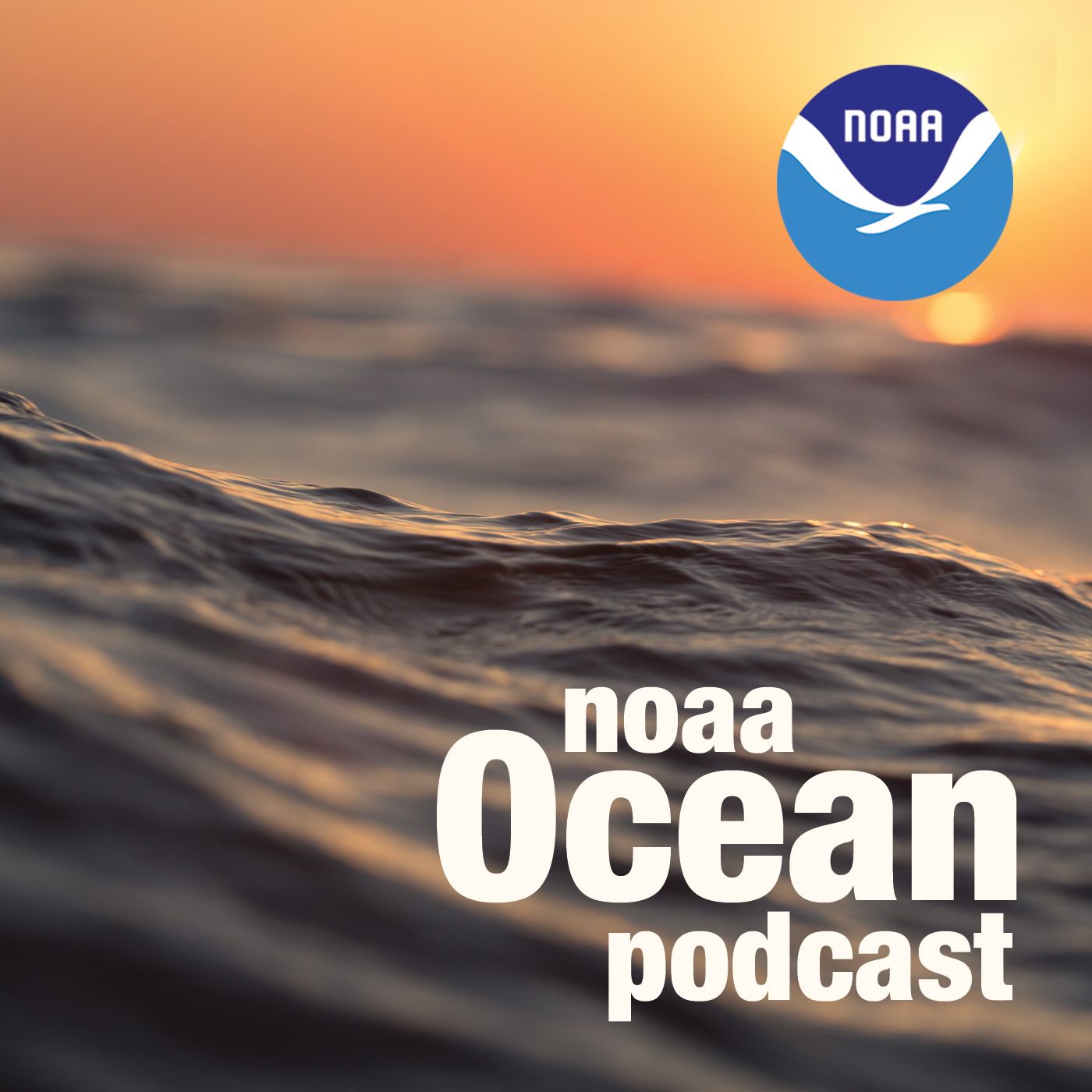The Microplastic-Mussel Connection: Part Two
NOAA Ocean Podcast: Episode 40
In this episode, we continue our conversation with two NOAA scientists about a study that looked at using mussels as "biomonitors" to measure microplastic pollution in the Great Lakes. Here, they discuss how their study was set up and how the scientific method works. Amy and Ed also discuss how unexpected results are often part of the scientific process, and how conducting a study in the field with living organisms is so challenging. This is part two of a two-part episode.

Podcast guests Amy V. Uhrin, chief scientist for NOAA’s Marine Debris Program, and Ed Johnson, physical scientist with NOAA's Mussel Watch Program. Here, Amy and Ed are shown collecting samples of invasive zebra mussels on a research vessel in Lake Michigan.
Transcript
HOST: This is the NOAA Ocean Podcast. I’m Troy Kitch. This is the second half of a two-part episode. If you missed that first one, check our show notes or look for it in your podcast player of choice. It’s called the The Microplastic-Mussel Connection: Part One.
We’re joined by Amy Uhrin, chief scientist for NOAA’s Marine Debris Program, and Ed Johnson, physical scientist with the Mussel Watch Program, which is part of NOAA's National Centers for Coastal Ocean Science.
In part one, Amy and Ed discussed their recent study in collaboration with Loyola University in Chicago that investigated the idea of using freshwater mussels in the Great Lakes to monitor microplastic pollution. And we also learned what the Mussel Watch program is all about.
In this episode, we continue our conversation about how their study was set up, which is a really great primer on how the scientific process works. Amy and Ed also discuss how unexpected results are often part of the scientific process, and how conducting a study in the field with living organisms is so challenging.
Amy, I want to ask if you could walk us through the study and, more broadly, talk about how the scientific process works.

Left image: Kimani Kimbrough, NOAA physical scientist with the Mussel Watch Program, recovers a mooring with caged mussels near the seawall at Jones Island wastewater treatment plant in Milwaukee, Wisconsin. Right image: Shelly Tomlinson, NOAA research oceanographer, and Beau Braymer, Cardinal Point Captains Northeast regional manager with NOAA's Great Lakes Environmental Research Laboratory, prepare to dive for mussels in Milwaukee Bay, Lake Michigan.
AMY UHRIN: The scientific method is a continuous process of acquiring knowledge, and it typically starts by someone making an observation about the natural world. So you’re out in nature, you see something that strikes you as interesting or curious, but you can’t really explain it. You’re not really sure why it’s happening, or why something is there. So you make an observation about something. Now tying everything back to our study, the observations that we knew about these freshwater mussels was minimal, but we had a lot of information from the published literature about bivalve species globally, and other species. So what we knew, going into this, is that many bivalve species that are sampled from their natural environment do have chemical pollutants in their bodies and do have microplastic in their bodies. And we also know that the invasive dreissenid mussels found in the Great Lakes are known to ingest microplastic in a lab setting.
And these freshwater mussels have long been collected in the wild and analyzed for chemical pollutants by the Great Lakes Mussel Watch Program, but they hadn’t yet been analyzed for microplastics. And also what we were aware of was that no studies had looked at the spatial and temporal abundance of microplastics from these mussels in the Great Lakes. So we had a lot of information generally about bivalves and about these freshwater mussels from a lab setting, but not a lot of data on collecting them from the wild. So those were the observations we were aware of and had made. And then, the next part of the scientific process is that you ask questions about those observations, and then you have to formally test those questions.
So for our study, our questions were: do these invasive mussels collected from Milwaukee Bay, specifically, have microplastics in their tissue? We also asked does the amount of microplastics in mussel tissue depend on the location in the Bay where the mussels are collected? And then, when presented together in the mussels, does the concentration of chemical pollutants, is it related to the amount of microplastics found in the mussel tissue?

Left to Right: Shelly Tomlinson, NOAA research oceanographer; Katie Miller, NOAA marine scientist; Ammar Hanif, 2018 NOAA Knauss Fellow; and Amy V. Uhrin, NOAA Marine Debris Program chief scientist, process mussels from Lake Michigan at the University of Wisconsin-Milwaukee School of Freshwater Sciences. Mussel samples were analyzed for body burdens of chemical contaminants, metabolomics, and biomarkers.
So after you think about the questions you’d like to ask, you have to form what is called a hypothesis. So you might have heard of this term. The word literally means ‘putting or placing under.’ So a hypothesis is the basis or the foundation for something. You can think of it as the potential answer to your questions. It might not be the correct answer, but it’s a possible or a feasible explanation. And so, in terms of a hypothesis, our hypotheses were, we had several: invasive mussels in Milwaukee Bay have microplastics in their tissue, that’s the first one; the second hypothesis was the amount of microplastic found in mussel tissue will depend on where in the Bay the mussel is collected; and then lastly, the concentration of chemical pollutants found in mussel tissue will be related to the amount of microplastic found in the tissue. So after you have your hypotheses formed, you develop a set of predictions based on those hypotheses. And so you can think of a prediction as simply the outcome that we would expect to see if our hypothesis is correct. And so, for this study, our predictions were that microplastics will be found in mussel tissue; that mussels sampled from locations that were close to sources of pollution in the Bay will have more microplastic in their tissue; and that microplastics and chemical pollutants that are found together in mussel tissues will have a positive relationship with one another — meaning that their values will move in the same direction. So if one goes up, the other will go up. So the more microplastics in the tissue, the more chemical pollutants in the tissue.
Host: And what are the next steps?
Amy Uhrin: So once you make your predictions, you then have to go through a series of either lab experiments or field experiments or field observational studies. And the purpose of those is to determine whether the observations you make during your study match up with what you predicted to happen. And if your study observations match your predictions, then your hypothesis is said to be supported and it’s likely correct. But if your study observations don’t match your predictions, then your hypothesis is not supported and it’s likely wrong.
So, in our case, we had some interesting results here. So the first was that, yes, we found microplastics in these freshwater invasive mussels. So that supported our first hypothesis. But then things got a little bit squirrelly for us. There was so much variation in microplastics concentration in the mussels across different mussel size classes, across the different months they were sampled, so that our second hypothesis was really only partially supported. Remember, we wanted to know at different points in the Bay, were concentrations of microplastics in the mussels different. And the answer is yes, but it depended on a lot of other factors. And then lastly, there was little evidence to support that microplastics and chemical contaminants were positively related to one another in the mussel tissue.
And so the final step in all of this, once you’ve got your results, is you, you know, depending on how well your results match your predictions, you might have to refine your original hypothesis, change it, alter it, even flat out reject it. And the very last thing is to reflect on your results, and you use them to guide any next steps that you might want to take. Perhaps another study. For our results, the initial conclusion is that these particular freshwater invasive mussels might not serve as a good biomonitor of plastic pollution the Great Lakes because the amount of microplastic found in the mussel tissue was very different among the different sizes of mussels, and very different between the time period that we collected. And these differences were the same as or higher than the differences among the sites. So there was just too much variation happening that we couldn’t definitively say or make any conclusions about spatial location in the bay. And so then what is usually done when you reflect on this is to suggest future studies. One that cropped up to us immediately was that we probably needed more collection sites spread out throughout the bay to better capture the different nuances of water quality within bay, and probably need to sample across more months. And then also perhaps it might be useful to conduct laboratory experiments to measure how chemical pollutants behave once they’re inside of mussels, whether or not those mussels have microplastics in their tissues. What’s happening internally with the mussel when it’s trying to process these type of pollutants.
Host: Ed, what are your thoughts on the study results. Were you surprised?
ED JOHNSON: No, I wasn’t surprised by the results. Amy did a great job of describing the scientific process and it’s difficult. Laboratory studies are way different than field studies. In the real world, in the field, there’s all sorts of variables that you can’t possibly control for. And so there’s a lot more unknowns than knowns here. We don’t have a clear answer yet. As an illustration of what I’m getting at, we know that bivalves filter food out of the water column, but they’re also pretty effective at getting rid of the potential food items that clearly aren’t appealing to them. They can be so selective to want to ingest a certain type of algae as a food source, but they’ll eject another kind of algae that they don’t like. Now that’s pretty fascinating.
Amy Uhrin: So Ed mentioned this selective ingestion and selective rejection by bivalves. We have a partner at the University of Connecticut that focuses on this, and so he found that in oysters, so the eastern oyster and in blue mussels — and these are lab studies — but did find that the more spherical particles were rejected more often than fibers. It’s a really cool finding that in their natural food items, they kind of selectively do this feeding, but they can also do it with these synthetic particles. I just wanted to add on to that.
Ed Johnson: In general, we think that when a scientific experiment is executed well, that can be demonstrated or proved because the experiment can be repeated with the same result. It’s generally easier to repeat laboratory experiments between two different labs trying to answer the same question, but the field studies in the real world are difficult to repeat.
Host: Amy, what are your thoughts about the work you do in the field, out in the natural world, so to speak?
Amy Uhrin: So, yeah, controlling for all the different environmental factors that are out there is impossible. All the things that can be influencing your systems or your organisms of interest. But another challenge when you’re doing field work is weather, in terms of its impact on your logistics, the logistics of sampling, impacts to sampling devices that you might have to leave deployed in the environment, and also how severe weather may or may not impact your actual study site physically. We’re marine biologists, right, so in our careers, Ed and I have used ships, small boats, divers to accomplish a lot of our work. Those resources can be expensive and often times, you know, there’s a schedule for when you can use the boat or the ship or when the divers are available. So you have this window of opportunity, and if the weather is not cooperating, you’ve got to roll with it. You’ve got to adjust on the fly. I mean, I’ve been blown off the water numerous times by storms and water spouts and I’ve lost sampling gear. And I had one of my sites, an underwater seagrass bed, that had completely become reconfigured because a tropical storm went through. And I’m sure Ed has a lot of stories like this as well. That’s another challenge of doing field work. You don’t know, when you get to your location, what’s going to happen on a day-to-day basis. You try to plan for it as best you can but still, weather is fickle.
Host: To wrap this up, Amy, what are the main points you want people to think about related to your study?
Amy Uhrin: Our results, they were all over the place, so to speak. This was a pilot study. So initially, our conclusion is that these particular mussels might not be the best choice as a biomonitor for microplastics in the Great Lakes. And that’s OK. That’s the whole point. You go in thinking, ‘oh, this is great. We’re going to measure all things. And, voila, we’re just going to incorporate microplastics into Mussel Watch forever.’ And it didn’t quite turn out that way. But there’s a lot of ways we can tweak this study and try to control for a lot of those environmental variables and extend our sampling, so that maybe the next time around, the result might be different. But it’s OK to initially say maybe these critters really aren’t the best choice for microplastic monitoring.
Host: And what would you say this tells us about the scientific process?
Amy Uhrin: A lot of times science is depicted as this infallible system of knowledge gathering, right? Where it’s very formulaic and it’s cut and dry, and it’s always portrayed as ending up very positive. So studies are conducted, the data supports what was expected, the results are published, and then those results get used to make some sort of management decision. And in our line of work, the decisions are usually how to manage some type of marine resource. But as Ed mentioned previously, negative or ambiguous results are also really important, and they’re a quite valuable part of the scientific process because, when you achieve those unexpected results, and you have that moment of ‘huh?’ You know, ‘why did that happen?’ You have to then critically evaluate what you’ve done, right? And you have to reconsider your current line of thinking on your topic, and it challenges you to redesign your study or your experiment, or maybe consider alternative explanations as you move forward. And that’s how science makes progress. And this is how studies complement and build upon one another. Even though our results might have been a little wishy-washy, you take that into consideration and you move forward the next time.
Host: Thanks, Amy and Ed, for taking the time to talk with me. This is the NOAA Ocean Podcast. Thanks for listening — check our show notes for links to this study, to the Marine Debris Program, and to the Mussel Watch Program. And subscribe to us in your podcast player of choice so you never miss an episode.

From corals to coastal science, connect with ocean experts to explore questions about the ocean environment.
Social